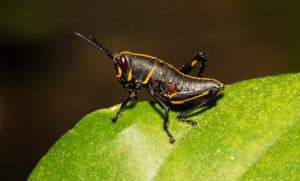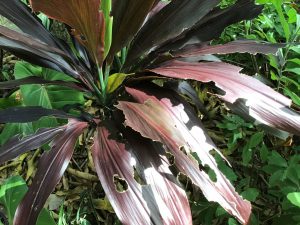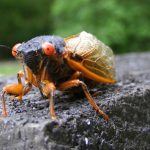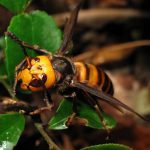No, not Brood X Periodical Cicadas – those are not found here in Florida. Not “murder hornets” either.
However, it is something equally disturbing (at least for many garden enthusiasts) – the eastern lubber grasshoppers have emerged from eggs laid last year. These emerged in abundance in my home garden this year and I think I know why. More on this a little further along.
According to a study conducted by the University of Florida, “this grasshopper is well known in the southeastern US, and elsewhere, due to its large size and widespread use in biology classrooms for dissection exercises. Also, it can be of economic importance in Florida. It is one of a few species of grasshoppers in Florida that occurs in large enough numbers to cause serious damage to citrus, vegetable crops, and landscape ornamentals” – I couldn’t agree more!
Ok, so they are colorful, large and will eat almost anything in your landscape. However, the fact that they can and will devour a large range of plant species may be new information for many gardeners – we have always heard they prefer lilies and amaryllis. Plants in this family contain toxins that help protect lubber grasshoppers from predation. These toxins also protect them from pesticides, however some treatments may be effective in controlling early instar stages. Shoot for first instar stage if you try this. As they develop and grow larger and if you have enough of them in y
of plant species may be new information for many gardeners – we have always heard they prefer lilies and amaryllis. Plants in this family contain toxins that help protect lubber grasshoppers from predation. These toxins also protect them from pesticides, however some treatments may be effective in controlling early instar stages. Shoot for first instar stage if you try this. As they develop and grow larger and if you have enough of them in y our landscape, this is when they wander and will consume a wider range of broadleaf plants.
our landscape, this is when they wander and will consume a wider range of broadleaf plants.
There are 5 instars (stages) after emergence, all black with a yellow/red stripe down the middle of their back and some cool yellow marking as well – These stages are your control window. We advise the “Smush” method or bag and freeze method for control. About a month after they reach adulthood, females can begin laying eggs to emerge again next spring. Lubbers can live for months often into November in our warm Florida climate. Females will continue to lay batches of eggs. Think lots of eggs to hatch next year!
They mate, and they may have a “song” or a warming click to potentially ward off other males (or maybe it is the females calling?) – you can do some exploration/observation on your own. These bugs are good for summer campers to observe in a cage. However, after observation please do not release them back into the wild; instead, freeze them in a plastic baggie. Let me know if you need any specimens for your summer camp!
So, what could be causing the huge increase in numbers in my yard this year? Some observations follow:
- Although I practiced the “smush” control method last year, many had already laid their eggs in the ground.
- Birds will not eat these, and I have not observed the African Agama lizards eating them either, so smush is recommended. And just in case, I will bag the smushed adults to prevent inadvertent egg release.
- Lubbers in my home landscape emerged early this warm year, maybe a longer life cycle allowed for more egg production/prolonged season?
- Note: I will be removing the Crinum asiaticum bed as it multiplies aggressively due to the amount of bulbs it produces. This will eliminate a major source of food. Also is it so large it is difficult to reach into and capture the lubber grasshoppers. below is a photo of the bed showing leaf damage and effects of dry weather this season.

I will leave you with this video link, Horticultural Extension Agent, Stephen Brown from Levy County Extension Office goes lubber hunting. Watch it if you dare. https://youtu.be/63raDZNbjvo
Information links below.
Guide to Collecting and Maintaining Live Arthropods for Classroom Display in Florida https://edis.ifas.ufl.edu/pdf/IN/IN75900.pdf
Insects: Friend or Foe? Color and Learn! https://edis.ifas.ufl.edu/pdf/IN/IN103000.pdf
Eastern Lubber Grasshopper, Romalea microptera (Beauvois) (=guttata (Houttuyn)) (Insecta: Orthoptera:Acrididae)1 https://edis.ifas.ufl.edu/pdf/IN/IN13200.pdf
p.s. our Florida Cicadas are loud……
Cicadas (of Florida), Neocicada hieroglyphica (Say), Tibicen, Diceroprocta and Cicadetta spp. (Insecta: Hemiptera: Cicadidae)1 https://edis.ifas.ufl.edu/pdf/IN/IN60200.pdf
Happy Gardening…….
 0
0




